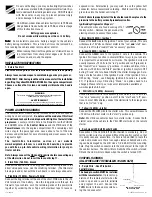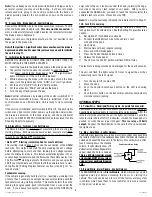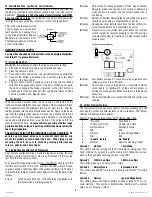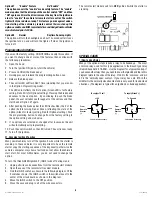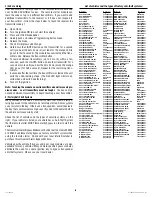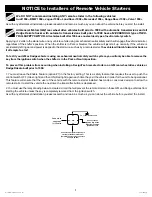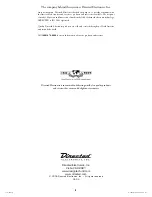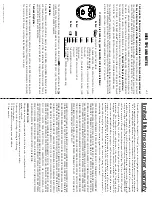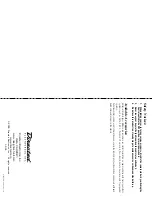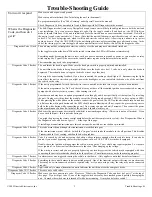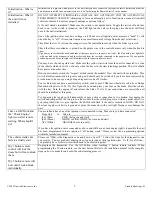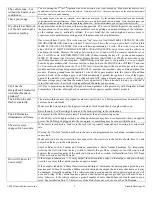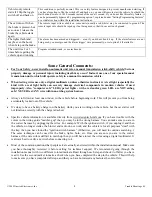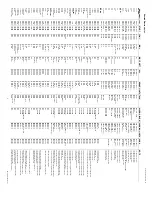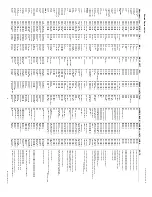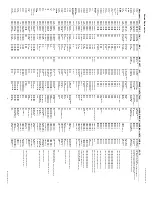
2
v5.3 (40026)
© 2005 Directed Electronics, Inc.
On cars with airbags, you may notice bright yellow tubes
or harnesses marked SRS (Supplemental Restraint Sys-
tem) underneath the steering column area. DO NOT tamper
with these wires in any way, to prevent personal injury
and/or damage to the air bag system.
On GM rear-wheel drive vehicles built prior to 1995 and
Dodge Dakota trucks built prior to 1996, see the last page
of this instruction manual.
Battery gases are explosive.
Do not smoke while working near the car’s battery.
Note
Note
Note
Note
Note::::: Some installers connect a battery charger to the vehicle’s
battery during installation. This is fine, but it must be removed be-
fore running the vehicle under remote starter control.
When running the wires through the car’s firewall, be sure
to protect them from sharp metal edges and from hot
surfaces on and around the engine.
INSTALLATION INSTRUCTIONS
1. Before You Start
Please read through the entire installation manual before beginning.
Always leave a window open to avoid locking your keys in your car.
IMPORTANT:
After having read the entire manual, start the installation
by putting the yellow WARNING STICKER in the engine compartment.
Choose a surface that is clean and readily visible when the hood is
open.
POWER & IGNITION HARNESS
The remote starter module will be installed under the dash once all
wiring has been completed.
Do not mount the module at this time!
You will need to check the red diagnostic LED light as the installation
progresses.
Locate (or drill) a hole in the firewall to run the PURPLE
and GREEN wires of the
Control Harness
and the PINK wire of the
Power Harness
into the engine compartment. The remaining short
wires stay in the passenger area. Leave about a foot of the wire
harness under the dash for ease of working and visual access to the
diagnostic light.
The Installation Information section of our website
www.designtech-intl.com is available 24 hours/day to provide
you with free, up-to-date vehicle wiring information for your par-
ticular vehicle.
Note: Always connect the
Pink and Black wires before connecting any
of the other wires. Do not insert the fuse until step 11.
2. Black Wire (16 AWG) - Ground
Connect the BLACK wire to a very good, clean chassis ground in the
driver’s kick panel area. Use the small ring terminal. (The thin metal
bracing around or beneath the dash board is not always adequate.)
3. Pink Wire (12 AWG) - Power (+12 Volts)
Connect the ring terminal at the end of the short PINK wire to the +12
Volt terminal of the battery. Run the long pink wire through the
firewall of your vehicle. Join the remaining ends of the power wire
together by soldering them. Tape with electrical tape to leave no
exposed wires. Alternatively, you may wish to use the yellow butt
connector, but we recommend soldering. Wait to insert the 30 amp
green fuse into the holder until step 11.
Note: Failure to properly install the fuse holder and 30 amp fuse to the
pink wire to the battery voids all product warranties.
Ignition Key Diagram for Steps 4-7
The vehicle’s wires are found coming off of
the key switch. Remove the panel under the
steering column to access these wires.
4. Blue Wire (14 AWG) - Ignition 1
Connect the
BLUE
wire to the ignition 1 wire of your vehicle. This wire
will m12 Volts on the test meter in the “run”
and
“start” posi-
tion, and is off in the “lock/off” and “accessory” positions.
5. Green (14 AWG) - Ignition 2
Connect the
GREEN
wire to the Ignition 2 wire in the vehicle. The
Ignition 2 wire can function in several different ways in your vehicle.
It is important to understand how it works. The Ignition 2 wire will
usually
m12 Volts in the “run” position and is off (ground) in
the “lock/off” and “accessory” positions. In certain vehicles, it may
also show +12 Volts in the “Start” position or Ignition 2 may turn OFF
during “Crank” and turn back ON after the starter disengages. Care-
fully note the function of the Ignition 2 wire. If the Ignition 2 turns
OFF during “Crank”, see Changing Ignition 2 Function in (section
21). If Ignition 2 stays ON during “Crank,” no options need to be
changed. Please refer to our wire color information available at
www.designtech-intl.com
6. White Wire (14 AWG) - Accessory
Connect the WHITE wire to the accessory wire which is +12 Volts in the
“run” and “accessory” position, but off in the “start” and “off” posi-
tions. In most GM vehicles, connect the white wire to the orange wire
that is hot in “run” only.
7. Yellow (14 AWG) – Starter
Connect the YELLOW wire to the starter wire. This wire will measure
+12 Volts on the test meter in the “start” position only.
Note:
Most Nissan vehicles have two starter wires. Connect both
starter wires of the vehicle to the YELLOW start wire of the remote
starter.
8. Dash-mount LED-On/0ff Control Switch
Connection of the LED-On/0ff Control Switch is mandatory. Do not
let the switch wires touch ground. Mount the control switch so that
it is easily seen and accessible. If a hole is to be drilled to route the
switch wire, make sure there is enough clearance behind and noth-
ing can be damaged by the drill. Use a 1/4" drill-bit for the mounting
hole. Plug the switch connector into the module just to the right of
the control harness. The LED will turn Red when the switch is turned
ON and the LED will turn Green when the switch is turned OFF.
CONTROL HARNESS
(ALL WIRES ARE THE SMALLER 18 AWG SIZE)
9. Purple Wire - Hood Pin Switch -
Control Harness
The hood pin switch MUST be installed
with the remote starter.
It prevents op-
eration of the remote starter when the
hood is open and is used to initialize
and program the unit. Connect the
PURPLE
wire to the hood pin switch us-
ing the red connector.
WARNING
This car is equipped with a remote control starting device.
Disable before working on car!
AVERTISSEMENT
Ce véhicule est équipé d’un systéme de démarrage a distance. Mettez-le
hors fonction avant d’eflectuer toute opération d’entretien ou de réparation!
How to share a hood pin
switch with an alarm
To Remote Starter
To Alarm


